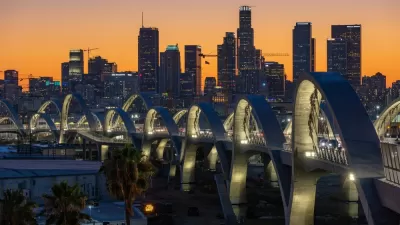City leaders from the Mayor on down recognize that infill development is necessary to create a more livable Los Angeles. So why does the public sector allow so many obstacles to stand in the way of small-scale development?
The constraints of existing infrastructure and regulation mean that the bulk of L.A.’s future growth will not come from large-scale redevelopment projects, but rather, from “more targeted development of a smaller scope and scale,” says Casey Lynch.
However, a number of factors conspire to limit the opportunities for such projects to proceed. “The most challenging demands stem from the opacity of the entitlements process, the cost of doing business, and the response times of city agencies,” argues Lynch, co-founder of Los Angeles development firm LocalConstruct. Smaller developers lack the resources to shoulder these burdens, rendering their projects costly, inefficient, and at times, infeasible.
“[I]n light of the potential for small scale development to reshape LA for the better, the public sector must work harder to alleviate the bureaucracy and costs that stifle so many promising projects,” says Lynch, who addresses some of the ways to remove these obstacles.
With two of the improvements he suggests - CEQA reform and the consolidation of City Planning and LADBS - building momentum, the prognosis for small developers may be improving already.
Thanks to Melody Wu
FULL STORY: PROTEST> PEE-WEE'S PLEA

Planetizen Federal Action Tracker
A weekly monitor of how Trump’s orders and actions are impacting planners and planning in America.

Maui's Vacation Rental Debate Turns Ugly
Verbal attacks, misinformation campaigns and fistfights plague a high-stakes debate to convert thousands of vacation rentals into long-term housing.

San Francisco Suspends Traffic Calming Amidst Record Deaths
Citing “a challenging fiscal landscape,” the city will cease the program on the heels of 42 traffic deaths, including 24 pedestrians.

Defunct Pittsburgh Power Plant to Become Residential Tower
A decommissioned steam heat plant will be redeveloped into almost 100 affordable housing units.

Trump Prompts Restructuring of Transportation Research Board in “Unprecedented Overreach”
The TRB has eliminated more than half of its committees including those focused on climate, equity, and cities.

Amtrak Rolls Out New Orleans to Alabama “Mardi Gras” Train
The new service will operate morning and evening departures between Mobile and New Orleans.
Urban Design for Planners 1: Software Tools
This six-course series explores essential urban design concepts using open source software and equips planners with the tools they need to participate fully in the urban design process.
Planning for Universal Design
Learn the tools for implementing Universal Design in planning regulations.
Heyer Gruel & Associates PA
JM Goldson LLC
Custer County Colorado
City of Camden Redevelopment Agency
City of Astoria
Transportation Research & Education Center (TREC) at Portland State University
Jefferson Parish Government
Camden Redevelopment Agency
City of Claremont





























